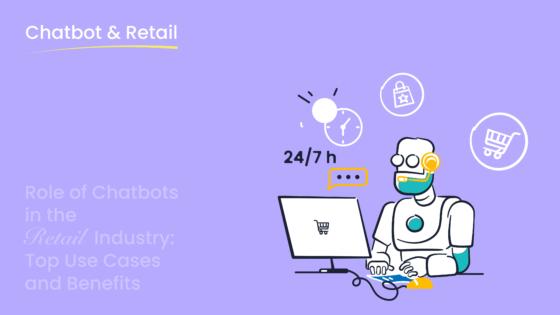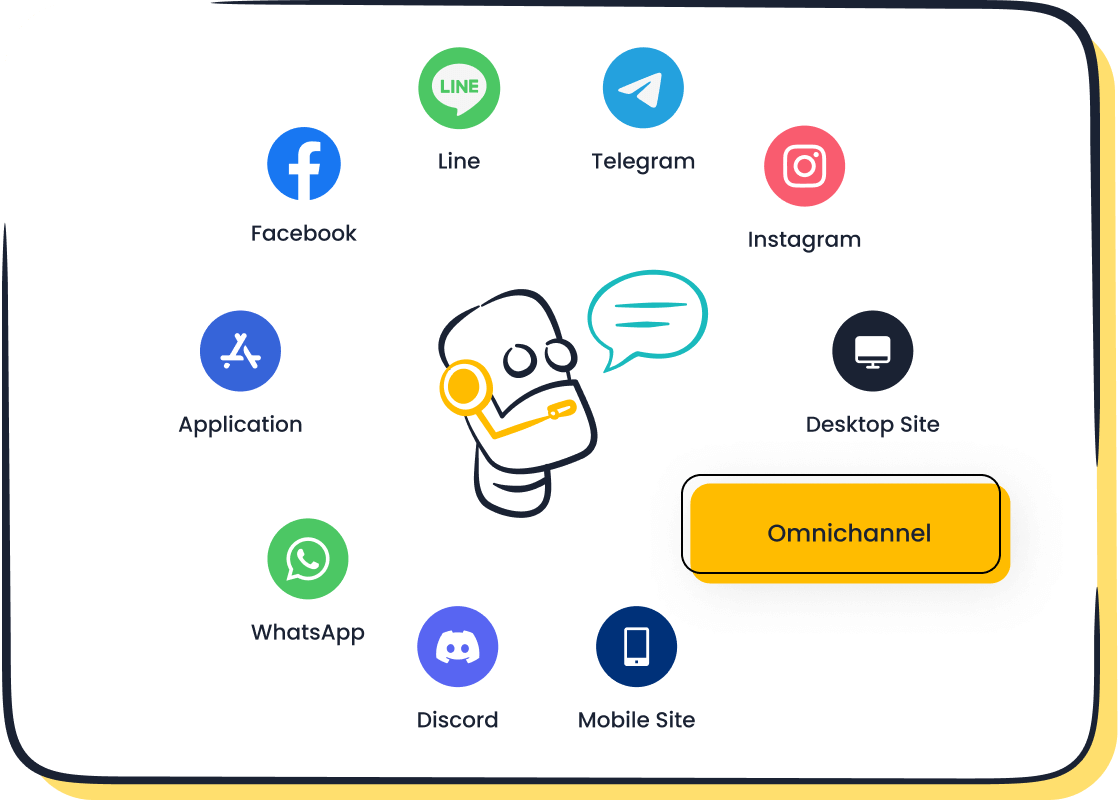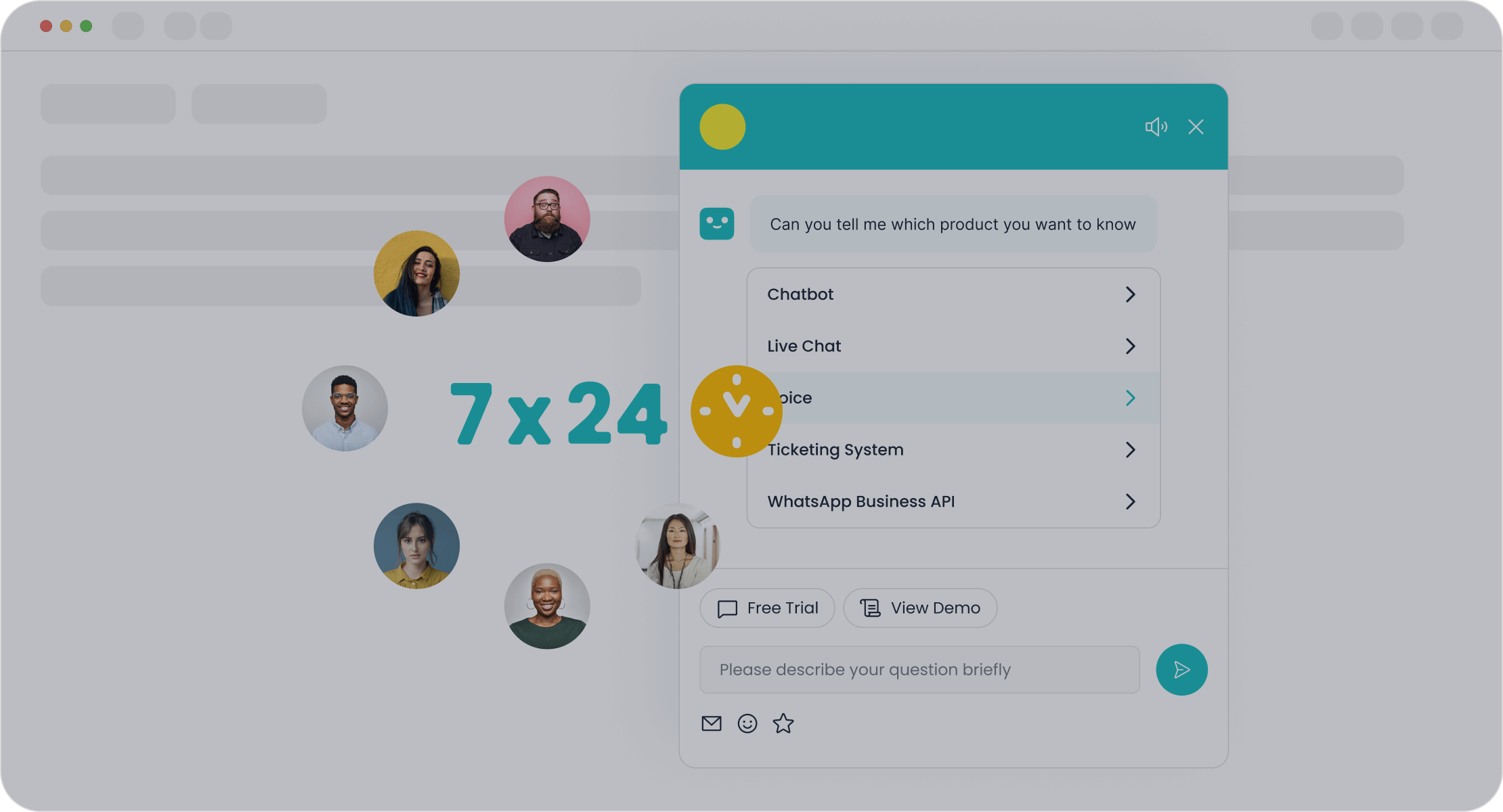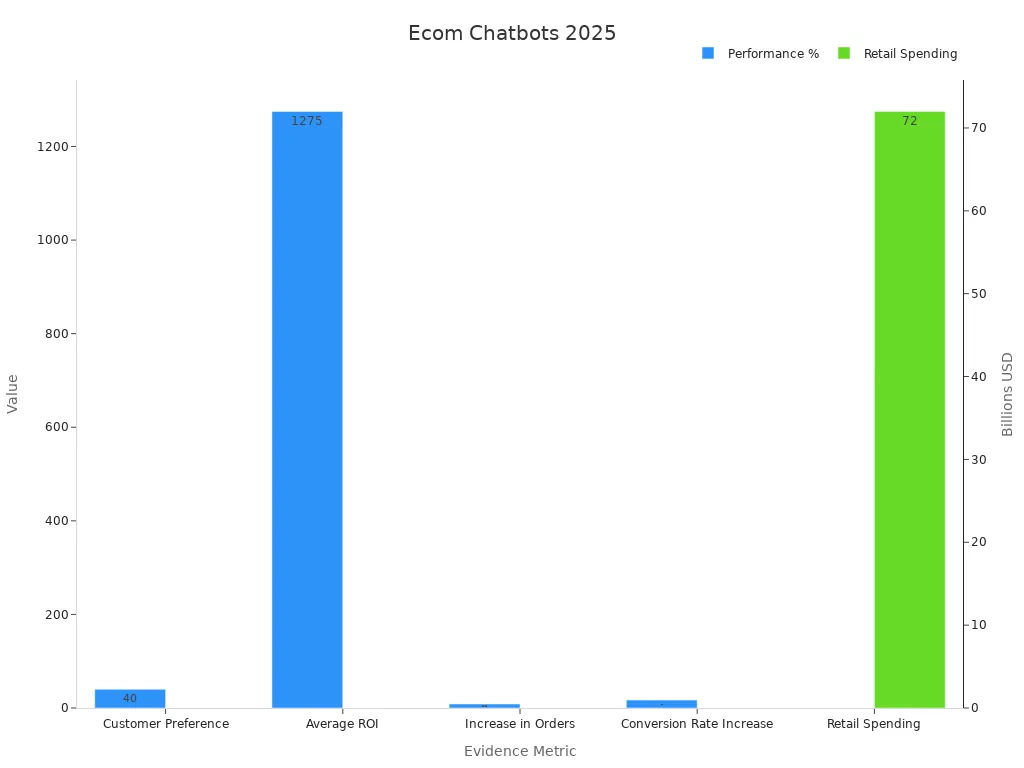Top E-commerce Chatbot Solutions for Online Stores in 2025

Imagine running your online store without the stress of managing endless customer inquiries. In 2025, e-commerce chatbot solutions are making this a reality. These AI-powered tools are not just answering questions—they're transforming how you connect with your customers. They handle up to 80% of routine queries, saving businesses billions globally while keeping customers happy. Companies like Sobot are leading the way, offering chatbots that boost sales by 67% and reduce support costs by 30%. With AI-driven personalization, your store can see a 20% rise in conversions, turning casual visitors into loyal buyers.
What Are E-commerce Chatbots and Why Are They Essential in 2025?
Definition of e-commerce chatbots
E-commerce chatbots are AI-powered tools designed to interact with your customers through text or voice. They simulate human conversations to answer questions, provide recommendations, and even assist with purchases. These chatbots work across multiple platforms, including websites, social media, and messaging apps. Think of them as your virtual sales assistants, always ready to help your customers.
Key benefits of using ecommerce chatbots
Ecommerce chatbots bring a lot to the table. They’re available 24/7, so your customers can get help anytime, even at midnight. They also save you money by reducing the need for a large customer service team. Plus, they make the shopping experience smoother by offering personalized product recommendations. For example, a global electronics store saw a 35% increase in order value after using a chatbot to suggest products and answer technical questions.
These chatbots also help recover abandoned shopping carts. They engage customers at the right moment, reminding them about items they left behind. And let’s not forget how they speed up customer service. A major fashion retailer reduced response times by 70% and cut costs by 30% after introducing an AI chatbot.
Trends driving the adoption of AI chatbots for ecommerce in 2025
The e-commerce landscape is evolving fast, and AI chatbots for ecommerce are leading the charge. Customers now expect instant responses. In fact, 90% of them define "immediate" as within 10 minutes. Chatbots meet this demand effortlessly. Companies like Caitlyn Minimalist have seen a 99% reduction in response times and a 150% increase in ticket conversions.
Conversation commerce chatbots are also becoming smarter. They use advanced AI to understand customer behavior and preferences. This means they can recommend products more accurately, boosting sales. For instance, TUSHY’s chatbot doubled their sales compared to human agents. With e-commerce chatbot solutions becoming more advanced, they’re set to dominate customer service by 2027, according to Gartner.
Top E-commerce Chatbot Solutions for Online Stores in 2025


Sobot Chatbot: AI-Powered Efficiency and Customization
If you're looking for a chatbot that combines efficiency with customization, Sobot Chatbot is a standout choice. Designed to handle customer interactions seamlessly, this AI-powered chatbot can transform how your online store operates. It doesn’t just answer questions—it solves problems, boosts conversions, and saves costs.
Sobot Chatbot excels in reducing workloads for your team. Over two years, it cut inbound discussion volumes by 20%, while 22.2% of customer questions were resolved independently. This means fewer repetitive tasks for your agents and more time to focus on complex issues. Plus, with a 97% customer satisfaction score (CSAT) and a 99% happiness rate, your customers will love the experience.
Here’s a quick look at Sobot Chatbot’s performance metrics:
| Metric/Outcome | Value |
|---|---|
| Reduction in inbound discussion volume | 20% |
| Increase in positive feedback | 96% + |
| Correct answers provided by AI | 80% |
| Customer satisfaction | 95% |
| Self-service question resolution | 22.2% |
| Customer satisfaction score (CSAT) | 97% |
| Problem resolution rate | 85% |
| Customer happiness rate | 99% |
| Increase in sign-off rate | 35% |
| Increase in COD collection rate | 40% |

What makes Sobot Chatbot even better is its customization. You can tailor it to your business needs without any coding. It supports multiple languages, operates 24/7, and integrates with popular platforms like WhatsApp and SMS. Whether you're a small business or a global brand, Sobot Chatbot adapts to your requirements effortlessly.
ChatGPT: Advanced Conversational AI for E-commerce
ChatGPT has revolutionized how businesses interact with customers. This advanced conversational AI tool doesn’t just respond—it understands. By analyzing customer interactions, it provides insights into preferences and trends. These insights help you refine your marketing strategies and offer personalized experiences.
One of ChatGPT’s biggest strengths is its ability to understand context and emotions. Imagine a customer asking about a delayed order. ChatGPT can detect frustration and respond empathetically, turning a negative experience into a positive one. This level of engagement increases customer satisfaction and loyalty.
Scalability is another key feature. ChatGPT can handle multiple inquiries at once, reducing the need for human agents. Whether it’s answering FAQs or assisting with purchases, it ensures your customers get instant support. For growing e-commerce businesses, this scalability is a game-changer.
Tidio: Multichannel Support for Small and Medium Businesses
Tidio is a popular choice for small and medium-sized e-commerce businesses. Its multichannel support allows you to connect with customers across platforms like email, live chat, and social media. This ensures you’re always available, no matter where your customers are.
Tidio focuses on improving customer satisfaction and retention. Here’s how it performs across key metrics:
| Metric | Description |
|---|---|
| Customer Satisfaction (CSAT) | Measures how products and services meet customer expectations. |
| Net Promoter Score (NPS) | Gauges customer loyalty and likelihood of recommending the business. |
| Customer Retention | Indicates the percentage of customers a business retains over a period. |
| Customer Effort Score (CES) | Assesses the ease of customer interaction and resolution of issues. |
| Return on Investment (ROI) | Evaluates the profitability of each channel used for customer engagement. |
| Conversion Rates | Tracks the percentage of visitors who complete a desired action. |
| Customer Acquisition Costs | Measures the cost associated with acquiring a new customer. |
| Customer Lifetime Value | Estimates the total revenue expected from a customer over their relationship. |
Tidio’s user-friendly interface makes it easy to set up and manage. It also offers automation features, helping you save time while improving response times. For small businesses looking to scale, Tidio provides a cost-effective solution.
Intercom: Customer Engagement and Support Simplified
When it comes to simplifying customer engagement, Intercom stands out as a top choice. It’s designed to help you connect with your customers in a way that feels personal and efficient. Whether you’re running a small online store or managing a large e-commerce platform, Intercom makes it easy to provide support that keeps your customers coming back.
One of Intercom’s biggest strengths is its ability to save time while improving customer satisfaction. For example:
- Nuuly achieved an impressive 96% Customer Satisfaction Score (CSAT) and saved over 50 hours of team time every month.
- Zip managed to save $500,000 in just seven months by increasing its self-serve support rate to 38%.
- Customers reported high satisfaction levels thanks to faster and more efficient support experiences.
Intercom also helps you streamline your operations. It automates repetitive tasks, so your team can focus on what really matters—building relationships with your customers. Plus, it’s great for onboarding new hires. Nuuly, for instance, improved its onboarding process, making collaboration and efficiency a breeze.
Here’s why Intercom is a game-changer for online store chatbots:
- It offers tools to automate responses to common questions, reducing the workload on your team.
- Its analytics provide insights into customer behavior, helping you refine your strategies.
- You can integrate it with your favorite platforms, making it a seamless addition to your e-commerce ecosystem.
If you’re looking for a solution that combines simplicity with powerful features, Intercom is worth considering. It’s not just about answering questions—it’s about creating meaningful connections with your customers.
ManyChat: Social Media and E-commerce Automation
If your business thrives on social media, ManyChat is the perfect tool to supercharge your efforts. It’s built to automate interactions on platforms like Facebook Messenger, Instagram, and WhatsApp, making it easier for you to engage with your audience and drive sales.
ManyChat shines when it comes to automating tasks that would otherwise take up a lot of your time. For instance:
- It helps with order tracking, abandoned cart recovery, and personalized product recommendations.
- You can set up automated follow-ups, re-engagement campaigns, and loyalty messaging to keep your customers engaged.
- AI-driven analytics track chatbot performance, engagement rates, and conversion metrics, giving you valuable insights to improve your strategies.
One standout example is The Pearl Source campaign, which generated over $64,400 in additional revenue from new customers. It achieved a 43% conversion rate and collected customer contact details for future marketing efforts. That’s the power of combining automation with smart analytics.
ManyChat also enhances the shopping experience by creating an interactive platform for product exploration. Customers can browse, ask questions, and even make purchases—all without leaving the chat. This level of convenience not only boosts sales but also builds trust and loyalty.
Here’s what makes ManyChat a must-have for conversation commerce chatbots:
- It provides detailed analytics and reporting features, so you can measure the effectiveness of your campaigns.
- Insights from these reports help you optimize your chatbot strategies for better performance.
- It’s easy to use, even if you’re new to automation, making it accessible for businesses of all sizes.
If you want to take your social media and e-commerce game to the next level, ManyChat is a tool you can’t ignore. It’s all about working smarter, not harder, to grow your business.
Features to Look for in the Best Ecommerce Chatbots
AI and machine learning capabilities
When choosing the best ecommerce chatbots, AI and machine learning capabilities should top your list. These features allow chatbots to learn from customer interactions and improve over time. They don’t just answer questions—they analyze data to provide smarter, more personalized shopping experiences. For instance, machine learning helps chatbots recommend products based on browsing history or past purchases. This real-time data evaluation ensures your customers see what they’re most likely to buy, boosting engagement and sales.
AI-powered chatbots also handle multiple inquiries simultaneously, offering quick, context-aware assistance. Imagine a customer asking about a delayed order. The chatbot can instantly pull up shipping details and provide an update. This kind of instant support not only saves time but also enhances customer satisfaction. Plus, by automating repetitive tasks, these chatbots free up your team to focus on more complex issues, making your operations more efficient.
Did you know? Incorporating AI into your chatbot can increase your eCommerce revenue by up to 15% through better customer engagement and personalized experiences.
Multichannel and omnichannel support
Your customers interact with your brand across multiple platforms—websites, social media, and messaging apps. That’s why multichannel and omnichannel support is a must-have feature for ecommerce chatbots. A chatbot with omnichannel capabilities ensures a seamless shopping experience, no matter where your customers are. For example, 70% of global consumers prefer brands that offer consistent service across all channels.
Omnichannel chatbots also reduce duplicate queries and improve response times. After deploying an omnichannel chatbot, businesses have seen a 37% drop in repetitive questions and a 58% improvement in first-response times. These tools make it easier for you to manage customer interactions while keeping satisfaction levels high. Whether your customers are browsing on Instagram or chatting on WhatsApp, they’ll enjoy a smooth, unified experience.
Integration with popular e-commerce platforms
A great chatbot doesn’t just work in isolation—it integrates seamlessly with your existing e-commerce platforms. Whether you’re using Shopify, WooCommerce, or Magento, integration ensures your chatbot can access product catalogs, order details, and customer data. This makes it easier to provide accurate, real-time assistance.
Take Kapiva, for example. By integrating their chatbot with their e-commerce platform, they achieved 86% automation and increased their CSAT score to 4.1. Similarly, Urban Gabru doubled their website sales and resolved customer queries in under a minute after connecting their chatbot to their platform. These success stories highlight how integration can streamline operations and drive sales.
When evaluating chatbots, look for those with no-code design features. This allows you to set up integrations without needing technical expertise. It’s a game-changer for businesses looking to save time and resources while enhancing their shopping experience.
Customization, scalability, and multilingual support
When it comes to choosing the right chatbot for your online store, customization, scalability, and multilingual support are game-changers. These features ensure your chatbot fits your business like a glove, grows with you, and connects with customers worldwide.
Customization lets you tailor the chatbot to your brand’s unique needs. You can design workflows, set up personalized responses, and even match the chatbot’s tone to your brand voice. For example, Sobot Chatbot offers a no-coding-required interface, making it easy to create a chatbot that feels like an extension of your team. Whether you’re a small boutique or a global retailer, customization ensures your chatbot delivers the experience your customers expect.
Scalability is essential as your business grows. A scalable chatbot can handle increasing customer inquiries without breaking a sweat. Imagine starting with a few hundred queries a day and scaling up to thousands during peak shopping seasons. With the right chatbot, you won’t need to worry about hiring extra agents or slowing down response times. It’s like having a customer service team that grows with your business.
Multilingual support is a must in today’s global market. A chatbot that speaks your customers’ languages can make all the difference. For instance:
- An international e-commerce provider saw a 30% boost in conversions by using a chatbot in 10 languages.
- A global travel company increased online bookings by 25% with a chatbot supporting 15 languages.
- A tech corporation achieved a 60% resolution rate in 20 languages, cutting costs by 45%.
These examples show how multilingual chatbots can improve customer satisfaction and drive sales. If you’re looking for the best ecommerce chatbots, prioritize these features to ensure your chatbot meets your business needs and exceeds customer expectations.
How to Choose the Right Chatbot for Your Online Store
Assessing your business needs and customer expectations
Choosing the right chatbot starts with understanding your business goals and what your customers expect. Are you looking to reduce response times, improve customer satisfaction, or boost sales? Pinpointing your priorities will help you focus on the features that matter most.
You also need to know your audience. What platforms do they use? Do they prefer quick answers or detailed assistance? Chatbot surveys can help you gather this information. They’re cost-effective, saving up to 30%, and they work 24/7 to collect data. Plus, 80% of customers prefer brands that offer conversational service, so using a chatbot aligns with their expectations.
| Benefit | Insight |
|---|---|
| Tailored Data Collection | Chatbot surveys allow for customizable prompts based on customer profiles, enhancing targeting. |
| Cost-Effectiveness | Automating surveys can reduce costs by up to 30%, allowing for budget-friendly insights. |
| Enhanced Customer Experience | 80% of consumers prefer brands offering conversational service, which chatbot surveys provide. |
Evaluating chatbot features, pricing, and ROI
Once you know your needs, it’s time to evaluate chatbot options. Start by listing the features you want, like AI capabilities, multilingual support, or integration with your e-commerce platform. Then, compare pricing and calculate the return on investment (ROI).
For example, a chatbot costing $1,160 monthly but saving $5,800 in customer service expenses delivers a 400% ROI. Don’t forget to factor in setup costs, training, and ongoing maintenance. Also, track metrics like customer satisfaction, conversion rates, and cost savings to measure success.
| Item | Value |
|---|---|
| Gains (monthly savings) | $5,800 |
| Chatbot cost | $1,160 |
| ROI calculation | 400% |
Considering ease of use and customer support
A chatbot should be easy to use for both you and your customers. Look for intuitive conversation flows that guide users smoothly. Chatbots with user-friendly bot builders make setup quick and hassle-free.
Customer support is equally important. Choose a provider with high ratings, like a 4.8/5 on platforms like G2 and Capterra. Strong support ensures you’ll get help when you need it, keeping your chatbot running smoothly.
Tip: A chatbot with seamless CRM integration and clear conversation flows can reduce user frustration and improve satisfaction.
Testing and implementing the chatbot effectively
Testing and implementing your chatbot doesn’t have to be overwhelming. With the right approach, you can ensure it works flawlessly and delivers the best experience for your customers. Here’s how you can make it happen.
Start with realistic test data
Your chatbot needs to understand real-world customer queries. Begin by gathering examples of the questions your customers ask most often. These could include inquiries about shipping, product availability, or returns. Use this data to create scenarios that mimic actual conversations. This step helps your chatbot respond accurately and naturally, making it feel more human.
Automate your test cases
Manual testing can be time-consuming and prone to errors. Automating your test cases speeds up the process and ensures consistency. Tools like test case replicators can help you set up automated tests quickly. For example, a QA team used automation to reduce manual effort and improve testing efficiency. This approach saved time and ensured the chatbot performed well under different conditions.
Optimize your automation framework
Testing doesn’t stop after the initial setup. Continuously improving your automation framework keeps your chatbot running smoothly. Regular updates help it adapt to new customer behaviors and queries. Businesses in industries like healthcare and finance have seen great results by refining their testing processes over time.
Roll out in phases
Launching your chatbot all at once can be risky. Instead, start small. Test it with a limited audience or on specific channels first. This phased rollout lets you identify and fix issues before expanding. It also gives you valuable feedback from early users, helping you fine-tune the chatbot for broader use.
Tip: Keep track of metrics like response accuracy, resolution rates, and customer satisfaction during testing. These insights will guide you in making improvements.
Integrate seamlessly
Finally, make sure your chatbot integrates well with your existing systems. Whether it’s your e-commerce platform, CRM, or social media channels, smooth integration ensures your chatbot can access the data it needs to assist customers effectively. A well-integrated chatbot doesn’t just answer questions—it enhances the overall shopping experience.
By following these steps, you’ll set your chatbot up for success. Testing and implementing it effectively ensures it becomes a valuable asset for your online store, boosting customer satisfaction and driving sales.
Benefits of Implementing AI Chatbots for Ecommerce

Enhanced customer engagement and satisfaction
AI chatbots for ecommerce are game-changers when it comes to keeping your customers engaged and happy. They’re available 24/7, so your customers never have to wait for answers. Imagine a shopper browsing your site late at night. Instead of leaving frustrated, they get instant help from your chatbot. This kind of round-the-clock support can increase customer satisfaction by 15%.
Chatbots also make the shopping experience more personal. They analyze customer behavior to recommend products that match their preferences. For example, if someone frequently buys skincare products, your chatbot can suggest a new moisturizer they might love. This personalized shopping experience builds trust and loyalty.
Did you know? 62% of consumers prefer using chatbots over waiting for human agents. That’s a huge opportunity to enhance customer engagement while saving time and resources.
| Findings | Details |
|---|---|
| Technology Acceptance Model | Chatbots improve customer satisfaction by adapting to user preferences. |
| Service Quality Model | High-quality chatbot interactions lead to better customer experiences. |
Boost conversions and sales through proactive interactions
Proactive chatbots don’t just wait for customers to ask questions—they take the first step. They greet visitors, offer assistance, and guide them through the buying process. This approach can significantly boost conversions. Businesses using chatbots have reported a 67% increase in sales.
Picture this: A customer is hesitating at checkout. Your chatbot steps in with a friendly message like, “Need help completing your order?” This simple nudge can reduce cart abandonment and turn a potential loss into a sale. Websites with chat support have seen a 38% increase in conversions and a 19% jump in revenue.
Tip: Engaging with a live chat agent makes customers 2.8 times more likely to make a purchase. Proactive interactions can make all the difference.
Streamlined customer support and operational efficiency
Automating customer support with AI chatbots can transform how your business operates. These chatbots handle routine tasks like answering FAQs, freeing up your team to focus on complex issues. This automation reduces customer support costs by 20% while improving efficiency.
Chatbots also process queries in real-time, cutting response times dramatically. They’re like having a super-efficient team member who never takes a break. Plus, they scale effortlessly. Whether you’re handling 100 or 10,000 inquiries, your chatbot can manage the load without breaking a sweat.
Pro Tip: By analyzing customer interactions, chatbots can identify trends and provide insights to improve your operations. This data-driven approach boosts both efficiency and customer experience.
Cost savings and 24/7 availability
Running an online store can be expensive, especially when it comes to customer support. But AI chatbots are changing the game. They help you save money while keeping your customers happy. How? By automating customer support, they handle routine questions without needing a human agent. This means you don’t have to pay for overtime or hire extra staff for night shifts. It’s like having a team that works around the clock without ever taking a break.
Here’s why 24/7 support is a game-changer:
- Your customers can get help anytime, even during holidays or late at night.
- Faster response times mean fewer abandoned carts and higher conversion rates.
- You capture sales opportunities that might otherwise slip away.
Big brands like Capital One and Ally Assist use chatbots to provide immediate assistance at all hours. This not only improves customer engagement but also builds loyalty. When customers know they can rely on you anytime, they’re more likely to stick around.
The financial benefits are just as impressive. By eliminating the need for after-hours staffing, you cut down on operational costs. Plus, round-the-clock service boosts customer satisfaction, reducing churn and increasing repeat purchases. Imagine saving up to 30% on support costs while improving your bottom line. That’s the power of AI chatbots.
With tools like Sobot Chatbot, you can offer seamless customer interactions across multiple channels. Whether it’s answering FAQs or guiding customers through purchases, these chatbots ensure your store runs smoothly day and night. It’s a win-win for you and your customers.
E-commerce chatbot solutions are revolutionizing online shopping in 2025. They’re not just tools; they’re essential for creating seamless customer interactions. With 40% of users preferring chatbots over live agents and an average ROI of 1275%, it’s clear why businesses are embracing this technology. These chatbots boost sales, improve customer satisfaction, and save costs.
Here’s a quick look at their impact:
| Evidence Type | Data/Statistic |
|---|---|
| Customer Preference | 40% of users prefer chatbots over live agents |
| Average ROI | 1275% |
| Increase in Orders | 8.5% increase in orders |
| Conversion Rate Increase | 17% increase in conversion rate |
| Retail Spending via Chatbots | Expected to hit $72 billion by 2028 |

Each solution we explored—Sobot Chatbot, ChatGPT, Tidio, Intercom, and ManyChat—offers unique benefits. Whether it’s Sobot’s unmatched efficiency and customization or ManyChat’s social media automation, there’s a chatbot for every business need.
If you’re ready to transform your online store, start with Sobot Chatbot. It’s designed to enhance customer interactions, boost conversions, and save costs. Don’t wait—embrace the future of e-commerce today!
FAQ
What is the main purpose of e-commerce chatbots?
E-commerce chatbots help you automate customer interactions. They answer questions, recommend products, and assist with purchases. This makes your store more efficient and improves the shopping experience for your customers.
Can chatbots handle customer questions 24/7?
Yes! Chatbots work around the clock. They’re always available to answer customer questions, even during holidays or late at night. This ensures your customers get instant support whenever they need it.
Do I need coding skills to set up a chatbot?
Not at all! Many chatbots, like Sobot Chatbot, offer no-code interfaces. You can easily customize workflows and responses using simple drag-and-drop tools. It’s designed to be user-friendly for everyone.
How do chatbots improve sales?
Chatbots boost sales by engaging customers proactively. They recommend products, recover abandoned carts, and guide shoppers through the buying process. This personalized approach increases conversions and builds customer loyalty.
Are chatbots secure for handling customer data?
Absolutely. Most chatbots, including Sobot Chatbot, prioritize data security. They comply with regulations like GDPR and use encryption to protect sensitive information. You can trust them to keep your customer data safe.
See Also
Best Ecommerce Live Chat Tools to Use in 2024
Enhancing Customer Satisfaction with E-commerce Chatbots
Increasing Sales with Ecommerce Live Chat Solutions